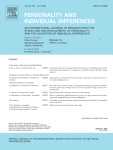lpetrich
Contributor
A lot of the animal-personality measures may be unfamiliar by human standards, but some of them may be interpreted as facets of extraversion, neuroticism, etc. For extraversion: activity, dominance, exploration (possibly also openness) etc. For neuroticism: the  Startle response is found over a wide range of species.
Startle response is found over a wide range of species.
- Serotonin transporter gene variation impacts innate fear processing: acoustic startle response and emotional startle | Molecular Psychiatry - human experiments
- Reduced brain serotonin activity disrupts prepulse inhibition of the acoustic startle reflex. Effects of 5,7-dihydroxytryptamine and p-chlorophenylalanine - PubMed - in rats
- Serotonergic Modulation of Walking in Drosophila: Current Biology - serotonin affects fruit flies' startle response
- Why Do We Freeze When Startled? New Study in Flies Points to Serotonin | Columbia | Zuckerman Institute
- Why do we freeze when startled? New study in flies points to serotonin -- ScienceDaily
- Human beings freeze when startled due to the nerves trigger of serotonin in the body- Technology News, Firstpost

